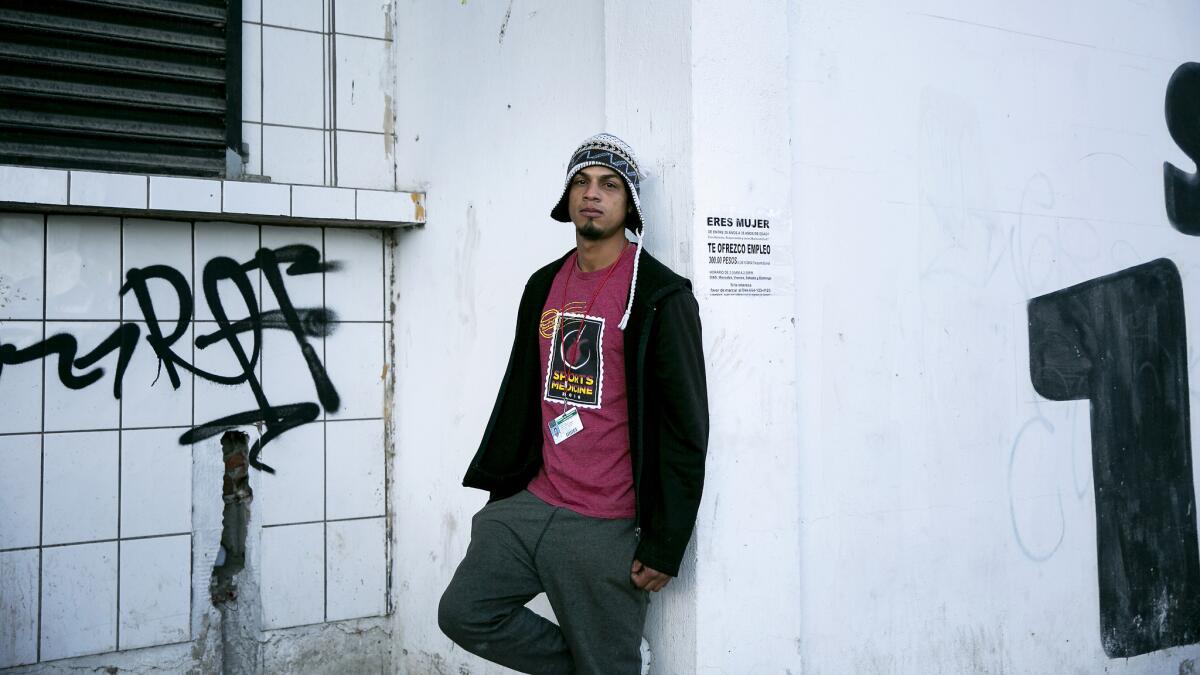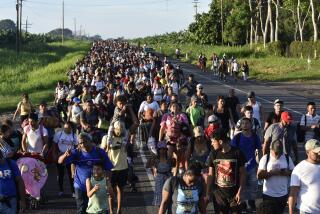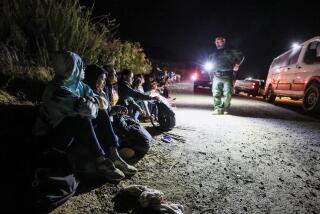Migrant describes capture by Border Patrol during tear gas deployment

When Juan Carlos Caballero Jones of Honduras heard the first tear gas canister fired off in the early hours of the new year, he decided the cover of chaos was the perfect opportunity.
“We all just want to advance our families,” he said later, shivering and clutching his stomach as he reflected on his failed attempt to enter the United States. “That’s what we all want to do. That’s what the whole world wants.”
U.S. Customs and Border Protection authorities said they fired tear gas and pepper spray into Mexico on Tuesday to stop about 150 migrants who tried to breach a border fence near Las Playas in Tijuana.
CBP said some of the migrants began to throw rocks at the agents from the Mexican side while others tried to cross the concertina wire, an additional security measure added when thousands of Central American migrants arrived in Tijuana in November with the goal of entering the United States.
A Department of Homeland Security spokeswoman said the crowd was “a violent mob of migrants” who attempted “to enter the United States illegally by attacking our agents with projectiles.”
Caballero was among those who went through three layers of razor wire.
“I looked for some high ground and covered my face, and then I gave it a shot,” he said. “I dropped down on the other side and landed on the ground and just crouched there.”
Though Caballero thought he had made it onto U.S. soil undetected, he said he stayed quiet in the brush for awhile, waiting for agents.
“I thought maybe I was free,” he said.
Tensions have been growing inside the El Barretal shelter, as federal volunteers talk of tapering off services in coming weeks.
Some migrants said they’re growing frustrated with being blocked from setting foot on U.S. soil so they can assert their legal right to trigger an asylum claim. Others said they’re confused about what they’re supposed to do.
There isn’t a physical line for those waiting to present themselves to U.S. immigration authorities through Tijuana. There’s a notebook managed by asylum seekers themselves that has traditionally helped keep order, but lately that process has been overwhelmed by the number of people waiting.
When the Central American migrants have approached ports of entry — if Mexican authorities allow them to get that far — they are often told they are either “at the wrong port” or that the port is “at capacity,” unless they are accompanied by lawyers or lawmakers drawing attention to their plight.
Under U.S. law, people approaching ports of entry have a right to ask for asylum, but border agents can tell them they have to wait. Lately, that wait has stretched into months.
Tijuana has become both the waiting room for the United States and a flash point in the immigration debate that has shut down the U.S. federal government as President Trump seeks funding for a border wall.
Those who approached the border early Tuesday said they did so with the intention of peacefully asking for asylum once on U.S. soil.
But according to Caballero, some wanted to try to make it onto the other side by avoiding detection altogether.
Caballero estimated he was in the United States for 40 minutes before he was spotted, initially by Border Patrol agents on the ground, and then by a helicopter.
“I crossed over some brush. Then I saw a guy on a quad and I saw that he saw me. I didn’t move. It turns out maybe he didn’t see me, so I went a little bit more,” he said.
Caballero said he stayed still for another five minutes and then he crossed over another section.
The disappointment in his voice was still fresh a day later when he recalled discovering that section just dropped off to another area also guarded by Border Patrol.
“I realized I had a little more to go to get free,” he said.
He said in that moment he was spotted by a helicopter crew.
“I guess they have some kind of sensor that detects your body heat,” he said. “I could tell the helicopter had homed in on me and turned the lights on me.”
Caballero said his whole body started to shake, and agents came to apprehend him.
“They started cussing at me in English,” he said. “And then I put my hands in the air and I asked for asylum.”
Caballero said the agents told him to go back to Mexico the same way he came.
“They wanted me to go back through the wire. They picked up my backpack and threw it to the other side,” he said.
Caballero said he argued with the agents for about 20 minutes.
Under U.S. law, once someone crosses into U.S. territory from Mexico, they have a right to ask for asylum. The U.S. government doesn’t have to grant asylum, but border agents at the line can’t force foreign nationals to return to Mexico without some processing of their asylum claim, according to civil rights attorney Eugene Iredale.
“We went back and forth because I wasn’t going to go back through the same area because I could get hurt,” Caballero said. “They just said ‘Get out, get out, get out.’ ”
Caballero said they eventually walked him back to the Mexican side.
A Department of Homeland Security official did not respond to questions about Caballero’s story, but a previously released statement said the agents acted with complete professionalism.
“The agents involved should be applauded for handling the situation with no reported injuries to the attackers,” said DHS spokeswoman Katie Waldman.
Caballero said he doesn’t see the night as a complete failure.
“I made it,” he said. “They made me come back but … I had passed all the obstacles. All the people will tell you. My legs are hurt. I’m not going to lie.”
And he said wasn’t discouraged from giving it another shot.
“With 10 more opportunities, I’d give it 10 more tries.”
Wendy Fry writes for the San Diego Union-Tribune.
More to Read
Sign up for Essential California
The most important California stories and recommendations in your inbox every morning.
You may occasionally receive promotional content from the Los Angeles Times.











